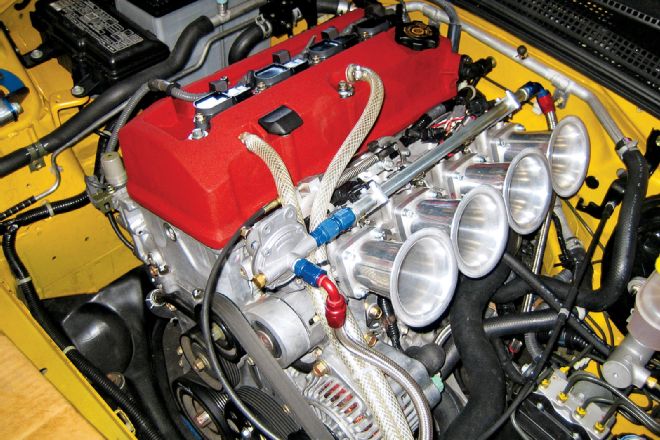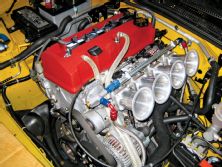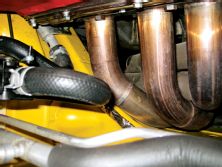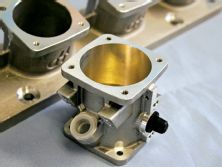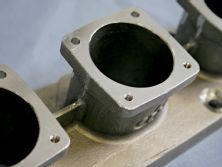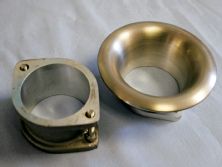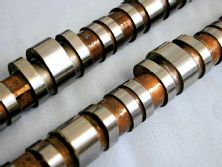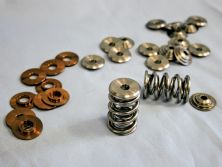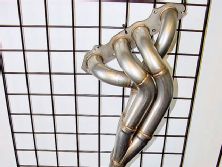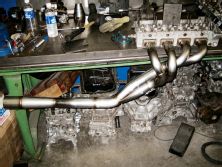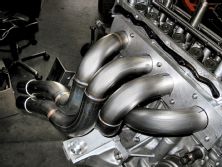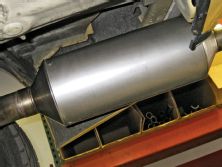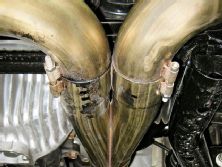The S2000 proved to be something different right from the start. It was a two-seater convertible built by a company mostly familiar with coupes and sedans. Its engine was odd too. Initially it came with 2.0 liters of displacement, twin cams, and a 9,000rpm powerband, yet Honda labeled it an F-series, which up until this time meant 2.2 liters of displacement, the absence of a second camshaft, and not a whole lot going on past 7,000 rpm. No, the F20C clearly had no more in common with the rest of the F camp than the name but instead foreshadowed Honda's upcoming four-cylinder hero: the K-series. Go figure.
Arguing with 240 hp protected under a three-year warranty is difficult, which is why most don't, but those who aren't afraid to mess with a good thing understand that there's a little something left behind that 240hp rating-you've just got to dig for it. Unlike the K-series, the F20C and F22C have been tough nuts to crack. Bolt-ons don't seem to add much. Headers generally yield 10-12hp gains, cold-air intakes, and exhaust systems less than that. And combinations of the three? Let's just say nobody's shattering any horsepower per dollar records when it comes to the S2000.
So what gives? Why is generating an extra 10 percent out of this F-series so difficult? It all comes down to everything Honda engineers did to get that much power in the first place. The years the engineers spent earning their stripes at the racetrack resulted in nothing short of a race car built for the street. What average tuners think should work usually doesn't and, since last time we checked, there aren't any retired Honda F1 guys hanging around the local tuner shops to help figure things out.
What about an old Formula Atlantic guy? Maybe somebody like that could help. HyTech Exhaust's John Grudynski was building headers for the Formula Atlantic series as soon as it started using 1.6L Toyota 4AG engines nearly 20 years ago. The 4AG is an 11,500rpm race-only engine. What John learned while tinkering with those helped him unravel the F-series' secrets years later.
The secret lies in the tuning approach. Call John's solution comprehensive tuning for lack of a better term. Throwing a hodgepodge of parts onto any engine, especially when everything comes from different manufacturers, doesn't usually work. Looking at the system as a whole and then making parts that work in harmony with one another is key. Change one and you just might lose all you've gained. Put them together and the sum is literally greater than the parts. This sounds very Zen and all but it's what worked for HyTech. How do you argue with 283 whp and a whopping 200 lb-ft of torque with just bolt-ons? John can't take all the credit for this philosophy though because Japanese tuners like Spoon Sports, Mugen, and FEEL'S have followed this same approach for decades. It seems only logical for us to give it a shot, which is exactly what John did. Drawing on his Atlantic car experiences, he had three intake and two exhaust camshafts made and went to the engine dyno. Over the course of a year, about 1,000 dyno pulls, and several headers and intakes, John realized the improvements that make the whole kit sing.
The kit is comprehensive, hence the terminology. The basis is, of course, the camshafts. There are also titanium retainers and new springs that work with the cams and then a set of 50mm Jenvey individual throttle bodies, and finally, HyTech's specialty, the header and exhaust-a complete long-tube 4-2-1 header with a 3-inch exit, race cat, and dual 2.5-inch muffler system. John used an AEM EMS to dial it all in.
John used a '06 S2000 with the 2.2L F22C1 for testing purposes. The engine was removed for dyno testing and then put back in the car for the final tune and dyno pulls at nearby Church Automotive Testing. True to bolt-on form, the bottom end remains completely stock-no piston alterations, cylinder head mods, or anything else uncouth-just cams, an intake, a header, and an exhaust. But wait a second; all of this sounds too good to be true. Similar parts' recipes have been fitted to the F-series before, none of which made anything near 283 whp. To find out what the deal really is we sat John down in hopes of revealing the secret details of his new S2000 bolt-on kit.
HT: John, how did you know where to start with this? HyTech has had a header for the S2000 for some time now and, while it might do a bit better than the others out there, it's no magic bullet. JG: Since the car came out and we did our header, we looked at what was happening with all of the other parts out there and realized power numbers were disappointing. I decided that what we had to do was start all over. I finally got a car that I could have for a long time and we started.
HT: What was the first component you went after? JG: The cams. The 2.2L motor was reverse engineered to get all the data on cam events and valve-to-piston clearances. From there we used the same application that we used for the Toyota Atlantic. The initial test showed that we were on the right track with just a few dyno pulls. The cams are very unlike what the aftermarket had been trying for profiles-this was a 180-degree change in direction from the norm. The cams are 8620 steel billet, which is much better than the chilled-iron cores. They are much stiffer and have less flex and twist, which gives more accurate cam timing. The exact specs are confidential but what we can tell you is that heavy attention was paid to the lobe centers for VTEC and the non-VTEC lobes. This in and of itself was a significant gain in how the power climbed from the non-VTEC lobes onto the VTEC ones through a seamless crossover. Normally, there is a slight drop in power when the motor goes into VTEC because it has to catch up with itself or re-accelerate when VTEC engages. HyTech's approach gives the engine the momentum to carry the power much sooner and better.
HT: Why use 8620 steel billet? What is it? JG: The 8620 material has been the material of choice for all cam manufacturers using roller lifters. The cast chilled-iron blanks are better for the old-style sled rockers (B-series) because you need dissimilar materials to make them live. Since we are running rollers that condition doesn't exist.
HT: What else about the cams? There has to be a little secret or two you can reveal. JG: The other big difference is the ramp speeds on the cam lobes. With the roller style valvetrain you have the ability to create some pretty fast opening rates for the valves. The problem is, if you open them too fast, the roller rocker cannot follow the lobe profile and that creates some pretty bad issues. Our approach was to create a profile the roller could follow, which gives us better control of the valve and ultimately made more power with a less aggressive ramp rate. Not what you would expect but then again this ain't no normal engine.
HT: Cool, and what about the intake? Why ITBs? JG: Like I said, it's a systems thing so we're doing all of this to match what we have without cracking the engine open. The stock head has really big ports, which is good for volume, but can be bad for velocity, especially in the midrange. A revised manifold could have easily taken longer to develop than the cams did, but ITBs, matched to a proper intake cam ... are you beginning to see why I decided to do everything?
HT: Yes, each one affects the other. So the ITBs, tell us about Jenvey. JG: The induction system came from Lance Hayward of Hayward Performance. Lance is the Jenvey dealer and Hayward makes a very nice S2000 manifold along with all of the proper pieces like a vacuum tree and water pipe. Jenvey throttle bodies are vastly different than other units. The three major differences are the location of the butterflies, the location of the shaft, and the style of the air horns. We ran the 50mm TWMs and found no power gains at all over the stock plenum. Just bolting on Jenveys made an instant gain and, with a little tweaking of the air horn lengths, they really came to life.
HT: They look incredible too. The last piece is your bread and butter, the header and exhaust. JG: HyTech's approach for the S2000 simply comes down to experience. The tubing diameter was critical since the ports are very generous in size. To help keep the velocity high we implemented a smaller pipe size off the cylinder head. By doing this it also affects the exhaust cam timing, so the two go hand in hand. This is where the experience of matching camshaft design with header technology can yield a big performance gain. One won't work without the other.
HT: And the header is your usual 4-2-1 design with long primaries and secondaries but we're noticing your cylinder pairing is different, why? JG: The old pairing is tried-and-true, which is why all of the other companies use it. In theory it works and looks good on paper, but this is the real world and we do real-world testing, and the results speak for themselves. Most companies just copy the front-runners and don't do the testing; if they did, they would have figured it out like HyTech did. Now more and more companies are using the sequential pairing. With old-style pairing, exhaust pulses are all timed evenly. Sequential pairing lines up pulses one behind the other and the two working together have more energy to help scavenging. If it didn't work, I wouldn't be in business.
HT: True. What about the rest of the system? JG: The header has a 3-inch collector that goes to a metal core race cat, not some junk high-flow thing. After that, it splits to a pair of 2.5-inch mufflers. The dual system yields a much nicer tone than a single exit does, mainly because of the length of pipes that runs to each muffler. One is shorter and one is longer. The longer one has a slight delay in releasing the exhaust pulse, so what you hear are double the pulses and that softens the tone. This technology was also used on the Lamborghini Diablo factory systems.
HT: You know that because you've actually made exhausts for the Diablo. So that's it then, basically just intake, cams, and exhaust. Now you have to tell us the bad news, the price. JG: The system is a kit and the only thing I'll sell separate is the header and exhaust because those will work on any S2000. If you already have an exhaust on your S2000, you still need this one. Again, it's matched to the header and the rest of the system. The cam set, including Kobe Japanese springs, hardened spring bases, new keepers, valve seals, and titanium retainers, is $2,500. The ITBs are $2,900 right now but the exchange rate is always changing. The header is $1,350 and the dual exhaust is $1,800. I also recommend cam gears, which I sell for $750, because all engines are not created equal and some fine-tuning will always be necessary.
HT: You have to have engine management for this too, correct? JG: Yes, we used the AEM box because the Hondata was not yet available. Included with the kit is our AEM calibration. The Hondata will be every bit as capable and should pass the scan portion of emissions testing as well.
HT: So you're happy with the results? JG: Yes, I wouldn't have released it if I wasn't. The Church Automotive dyno reads a bit high, but the baseline was 240 and we're up nearly 50 hp from that, but the torque is where the kit really excels. The difference between stock and the HyTech kit is amazing.
HT: How does it drive with those ITBs? They can be a handful. JG: The driving experience is a welcomed surprise. It starts right up and purrs at 900 rpm. Street driving on the small lobes is very smooth and predictable but when you mash the go pedal, she jumps and before you know it, you're passing 100 mph. The torque feels like a supercharged setup but way more responsive.
HT: Thanks, John. When can we buy all of this? JG: By the time this prints I should have 20 kits ready. If they aren't, the wait won't be long.
HT: Anything else? JG: Yes, please don't ask, I won't sell just the cams. I won't sell just the ITBs. I've done all the research here. They won't work as well with a stock intake manifold and a different exhaust. We are, however, working on a new plenum that will go with the kit instead of the ITBs. It will just take time to R&D it. Oh, and the improvement should be just as large on the 2.0L engine.

